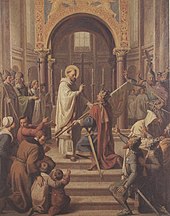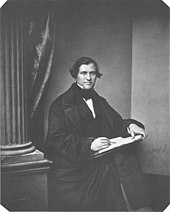Johann von Schraudolph

Johann von Schraudolph (born June 13, 1808 in Oberstdorf ; † May 31, 1879 in Munich ; also Johann , Johannes von and baptismal name Johann Baptist Schraudolph ) was a German church and history painter , in the art style of the Nazarenes .
Life
Johann Schraudolph was the son of a carpenter and apprenticed to his father. From 1825 he studied at the art academy in Munich , came to the Glyptothek as an assistant to Joseph Schlotthauer and there learned the technique of fresco painting. Schraudolph realized Heinrich Heß's design drawings for a glass painting intended for Regensburg Cathedral and supported him in the execution of the Nazarene frescoes in the All Saints Court Church and the basilica of St. Boniface Abbey in Munich, both of which were destroyed in World War II. With Joseph Anton Fischer , he created cardboard boxes for the stained glass in the Maria-Hilf-Kirche in der Au , the windows of which also fell victim to the Second World War.
His artistic breakthrough brought about the painting of the Speyer Cathedral on behalf of the Bavarian King Ludwig I. The design of the Palatinate Cathedral became his most extensive work.
In 1848 Schraudolph received the Bavarian Order of Merit from St. Michael ; on October 1, 1849 he advanced to professor at the Academy of Fine Arts in Munich and was one of the first to receive the Maximilians Order for Art and Science . The city of Speyer granted him honorary citizenship and King Ludwig I of Bavaria raised him to the nobility in 1862 ( Bavarian staff nobility ). The painter was of great personal piety, his son Franz became a priest in 1861, served as chaplain in Lenggries , but died young. Schraudolph's daughter Anna married Otto Reither from Göcklingen in the Palatinate in 1867 , the nephew of the later Speyer bishop Konrad Reither . The latter became a close friend of Schraudolph during the years of painting the cathedral and, as a cleric cleric, he always carried out the necessary correspondence between the artist and the king.
Because of a worsening gout condition and a noticeable turning away from the younger generation of artists from his painting style, Schraudolph resigned from his position as a teacher at the Academy of Fine Arts in Munich in 1878 and retired into private life. When the artist was buried in the old southern cemetery in Munich in 1879 , he only received a “modest burial escort” and “only a very small group of former students had come to pay the usual last respects to the departed.”; including Max Fürst (1846–1917), who once learned church painting from him and in 1908, on his 100th birthday, wrote an honorable obituary in the magazine “ Die christliche Kunst ” (Munich). Other well-known students were Ludwig Glötzle (1847–1929), Albrecht Steiner von Felsburg (1838–1905), Mathias Schmid (1835–1923), Max Bentele (1825–1893), Alois Gabl (1845–1893) and Hermann Arnold (1846 -1896).
His brothers Claudius Schraudolph (the elder) and Matthias Schraudolph and his son Claudius Schraudolph (the younger) also worked as painters.
tomb
The tomb of Johann Schraudolph is on the old southern cemetery in Munich (burial ground 15 - Series 1 - # 50) location .
Painting of the Speyer Cathedral



As a result of wars and the events of the revolution, the interior of the Speyer Cathedral was completely looted and largely unadorned. The diocese of Speyer, re-established as a purely Bavarian diocese in 1817 within new boundaries, finally needed a dignified episcopal church. King Ludwig I of Bavaria wrote in his diary on March 21, 1843 that the idea had occurred to him to have the Speyer Cathedral painted. In doing so, he was guided by the idea of educating the people to have a sense of the beautiful and the good. Art should " not be biscuit for the people, but daily bread ". On June 13, 1843, the monarch visited the episcopal church. In his wake were Johann Baptist Schraudolph and his teacher Heinrich Maria von Hess. After leaving the cathedral, King Ludwig declared:
- “ I have decided to have the cathedral painted. It starts in 1845! «
Because of his age, Heinrich Hess asked Schraudolph to do the work alone. A contract was signed with him on October 2, 1844, which also outlined the image program. As the main patron saint of the cathedral, the most important part of the picture was reserved for the Virgin Mary . The other representations mainly related to the secondary patrons of the episcopal church or to events in its history. Bishop Nikolaus von Weis had chosen the topic for the new decoration of his cathedral.
The work began with a service on June 8, 1846 and on that day Schraudolph created the complete head of God the Father. The artist carried out the last brushstroke on September 10, 1853, when he was finishing his votive fresco in the vestibule, on which he was kneeling in a painter's smock at the feet of the Madonna.
Johann Schraudolph had created 40 large frescoes and around 60 separate individual figures in the Speyer Cathedral. He immortalized the client King Ludwig I as Saul in the monumental fresco of the "Stoning of Stephen". He and his son, King Maximilian II, were enthusiastic about Schraudolph's monumental work. Maximilian - a rather sober monarch - said that he had looked at the pictures in the Speyer Cathedral at any time of the day and in all lighting conditions, he didn't know of a more beautiful church than this. Bishop Nikolaus von Weis was so moved by the sacredness of the frescoes that he wrote various pastoral letters about them in order to appreciate them in detail. Most of the contemporaries were deeply impressed by the successful creation.
But by the end of the 19th century, critics began to disparage and ridicule the decidedly religious art movement of the Nazarenes. Gradually the Speyer cathedral painting no longer corresponded to the taste of the time. In the period after the Second World War, the idea of removing all or part of the paintings in order to restore an allegedly Romanesque originality to the cathedral began to arise. It was based on the false and time-related hypothesis that the Romanesque did not have any splendor of colors, but was content with light-colored plaster and natural stone. This has now been completely refuted.
The Speyer Cathedral was the only larger, completely painted church in the Nazarene style that survived the hail of bombs of the Second World War undamaged. Regardless of this fact, all Schraudolph paintings were removed from 1957–1961, with the exception of a few small-format frescoes (Marien cycle) in the nave and the votive picture in the vestibule. Some of the monumental paintings were pulled off on rolls in order to preserve Schraudolph's painting at least as evidence for posterity. Most of the construction workers carelessly knocked off the vaults with hammers and picks, and they are irretrievably lost.
In the meantime, art research has produced new results and tastes in art have also changed. What was considered the cheap kitsch of the 19th century around 1960 is again considered outstanding art today. Recently, therefore, the restoration of the frescoes, which were damaged as a result of the long storage, has begun. Several of them have been permanently exhibited in the Imperial Hall of the Speyer Cathedral since 2012 and made accessible to the public again. Because of their monumentality and also for reasons of cost, the few remaining frescoes have not yet been used. The European Foundation Kaiserdom zu Speyer and other institutions are collecting funds to save the still preserved frescoes and to present them according to their importance. An international symposium in Speyer in September 2013 resulted in a positive reassessment of the Schraudolph frescoes.
Family tribe list
- Ignaz Schraudolph (1785–1851), cabinet maker, painter, draftsman in Oberstdorf
-
Johann von Schraudolph (* 1808 in Oberstdorf; † 1879 in Munich), church and history painter.
- Claudius Schraudolph the Younger (* 1843 in Munich; † 1902 in St. Michael in Eppan, South Tyrol, Italy), painter and illustrator.
- Claudius Schraudolph the Elder (* 1813 in Oberstdorf, † 1891 in Oberstdorf), history painter, lithographer, draftsman, employee of his brother in Munich and Speyer.
- Matthias Schraudolph, also Frater Lucas OSB, (* 1817 in Oberstdorf; † 1863 in Metten), history painter, Benedictine monastery in Metten since 1840.
-
Johann von Schraudolph (* 1808 in Oberstdorf; † 1879 in Munich), church and history painter.
literature
- Angelika Burger: Schraudolph, Johann von. In: New German Biography (NDB). Volume 23, Duncker & Humblot, Berlin 2007, ISBN 978-3-428-11204-3 , p. 522 f. ( Digitized version ).
- Sabine Fastert: Back to the early Christians. Johann Schraudolph and the picture program for the Speyer Cathedral . In: Das Münster 65 (2012), pp. 76–81. ISSN 0027-299X .
- Klaus Haarlammert: The painter Schraudolph in the Speyer Cathedral . Plöger, Annweiler 2003, ISBN 3-89857-157-2 .
- Hyacinth Holland : Schraudolph, Johann v. In: Allgemeine Deutsche Biographie (ADB). Volume 32, Duncker & Humblot, Leipzig 1891, pp. 453-461.
- Hans-Jürgen Kotzur , Bettina Schüpke (ed.): Pious simplicity, noble art? The Speyer cathedral frescos by Johann Baptist Schraudolph . Pilgerverlag, Annweiler 2012. ISBN 978-3-942133-55-5 .
- Margit Ksoll-Marcon : Johann von Schraudolph. In: Biographisch-Bibliographisches Kirchenlexikon (BBKL). Volume 9, Bautz, Herzberg 1995, ISBN 3-88309-058-1 , Sp. 916-919.
- Franz Siepe : Nazarene Renaissance. Chipped off fifty years ago, valued today: Johann Schraudolph's frescoes are exhibited in the Imperial Hall of Speyer Cathedral. In: Frankfurter Allgemeine Zeitung, April 10, 2013, p. N4.
Web links
- Literature by and about Johann von Schraudolph in the catalog of the German National Library
- Official website of the Speyer Cathedral with information on the Schraudolph exhibition
- Schraudolph's grave cross in the old southern cemetery in Munich (inscription renewed)
Individual evidence
- ^ Johann Schraudolph in the matriculation database of the Academy of Fine Arts Munich
- ↑ Schraudolph as an honorary citizen of the city of Speyer ( Memento from September 8, 2006 in the Internet Archive )
- ↑ Max Fürst : "Johann von Schraudolph on the 100th birthday", in "Die christliche Kunst", year 1907/1908, pages 290-294
- ↑ Nikolaus Lauer: "The Dommaler" in " Der Pilger ", No. 5, of December 30, 1945
- ↑ Website on the Schraudolph frescoes on display in the Imperial Hall of the Speyer Cathedral
- ↑ Heimatmuseum Oberstdorf: Appeal for donations to save the "Schraudolph frescoes"
- ↑ Despised art revalued. (No longer available online.) Diocese of Speyer, September 28, 2013, archived from the original on January 27, 2016 ; accessed on March 31, 2015 .
- ↑ Great complete work of the Annunciation. The Pilgrim, October 17, 2013, accessed March 31, 2015 .
| personal data | |
|---|---|
| SURNAME | Schraudolph, Johann von |
| ALTERNATIVE NAMES | Schraudolph, Johann; Schraudolph, Johann Baptist |
| BRIEF DESCRIPTION | German painter and etcher |
| DATE OF BIRTH | June 13, 1808 |
| PLACE OF BIRTH | Oberstdorf |
| DATE OF DEATH | May 31, 1879 |
| Place of death | Munich |


